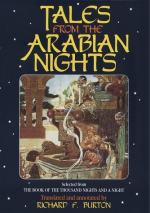[FN#19] The captain, the skipper, not the owner: see vols. i. 127; vi. 12; the fem. (which we shall presently find) is “Ra’isah.”
[FN#20] Scott (p. 246) has:—“At length the vessel anchored near a city, to which the captain went to make preparations for his marriage; but the lady, while he was on shore, addressed the ship’s crew, setting forth with such force his treacherous conduct to herself, and offering such rewards if they would convey her to her lover at the port they had left, that the honest sailors were moved in her favour, agreed to obey her as their mistress, and hoisting sail, left the master to shift for himself.”
[FN#21] In text “Kamrah,” = the chief cabin, from the Gr. {Greek}(?) = vault; Pers. Kamar; Lat. “Camara”; Germ. “Kammer.” It is still the popular term in Egypt for the “cuddy,” which is derived from Pers. “Kadah” = a room.
[FN#22] Scott makes the doughty damsel (p. 249), “relate to them her own adventures, and assure them that when she should have rejoined her lover, they should, if they choose it be honourably restored to their homes; but in the mean time she hoped they would contentedly share her fortunes.”
[FN#23] In text “Fidawi,” see “Fida’i” and “Fidawiyah,” suppl. col. iv. 220.
[FN#24] [In the text “Al-Kazanat,” pl. of “Kazan,” which occurs in Spitta Bey’s tales under the form “Kazan” on account of the accent. It is the Turkish “Kazghan,” vulgarly pronounced “Kazan,” and takes in Persian generally the form “Kazkan.” In Night 652 it will be met again in the sense of crucibles.—St.]
[FN#25] In text “Banj al-tayyar,” i.e. volatile: as we should say, that which flies fastest to the brain.
[FN#26] This marvellous bird, the “Ter-il-bas” (Tayr Taus?), is a particular kind of peacock which is introduced with a monstrous amount of nonsense about “Dagon and his son Bil-il-Sanan” and made to determine elections by alighting upon the head of one of the candidates in Chavis and Cazotte, “History of Yamalladdin (Jamal al-Din), Prince of Great Katay” (Khata = Cathay = China). See Heron, iv. 159.
[FN#27] Lit. “hath given it to him.”
[FN#28] Arab. “Jihaz,” the Egypt. “Gahaz,” which is the Scotch “tocher,” and must not be confounded with the “Mahr” = dowry, settled by the husband upon the wife. Usually it consists of sundry articles of dress and ornament, furniture (matting and bedding carpets, divans, cushions and kitchen utensils), to which the Badawi add “Gribahs” (water-skins) querns, and pestles with mortars. These are usually carried by camels from the bride’s house to the bridegroom’s: they are the wife’s property, and if divorced she takes them away with her and the husband has no control over the married woman’s capital, interest or gains. For other details see Lane M.E. chapt. vi. and Herklots chapt. xiv. sec. 7.
[FN#29] [Arab. “Shuwar” = trousseau, whence the verb “shawwara binta-hu” = he gave a marriage outfit to his daughter. See Dozy Suppl. s. v. and Arnold Chrestom. 157, 1. —St.]




